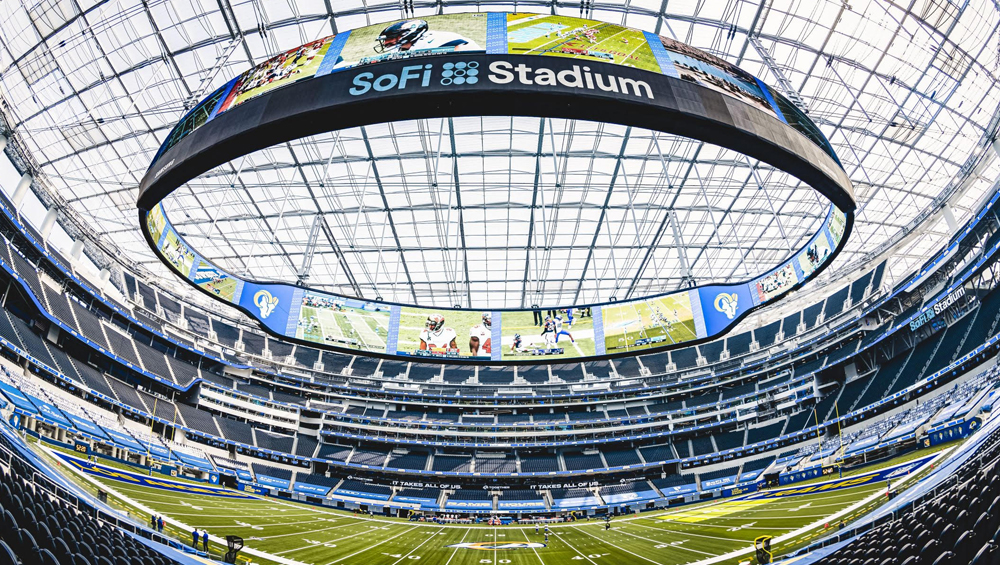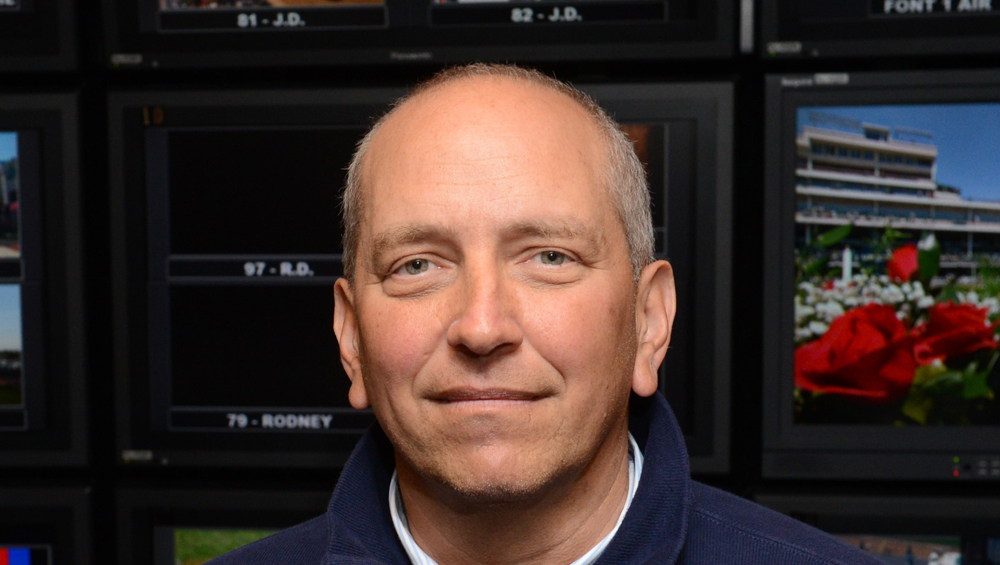
NBC Sticks To ‘Sunday Night Football’ Playbook For The Super Bowl

After compelling NFL divisional playoff and conference championship rounds that saw three games decided by last-second field goals and two others go to overtime, NBC is hoping for similar drama this Sunday in Super Bowl 56 at SoFi Stadium in Los Angeles.
“The quality of play, especially the playoffs, has been unbelievable,” says Super Bowl 56 Executive Producer Fred Gaudelli. “This is probably as exciting a playoffs as I can remember, and this is my 32nd year doing the NFL.”
The matchup between the Cincinnati Bengals and Los Angeles Rams is NBC’s 20th Super Bowl broadcast and its first in four years, as the network has switched up the traditional three-year rotation with fellow NFL rightsholders CBS and Fox to align its Super Bowls with its Winter Olympics coverage. As such, NBC’s Super Bowl pregame show and game broadcast will be bookended by morning and evening coverage of the 2022 Winter Olympics in Beijing, China. NBC’s Super Bowl coverage will be carried live for the first time on both the NBCUniversal streaming service Peacock and the Spanish-language broadcast network Telemundo.

NBC Sports’ Drew Esocoff: “The more you can stick with what got you to where you are, the better off you are.”
While NBC’s Winter Olympics coverage is being produced in a large-scale remote production model from the NBC Sports complex in Stamford, Conn., its Super Bowl coverage is following a traditional model with most production staff and technology onsite. More than 1,000 people have been credentialed for the Super Bowl, with probably 500 involved in the actual game coverage between production, engineering and vendor staff, says Tim DeKime, VP of sports operations for NBC Sports. NBC has about 14 mobile trucks onsite between the game and the pregame show, supplied by NEP Group and its subsidiaries Aerial Video Systems and Broadcast Sports International.
NBC produced its regular-season Sunday Night Football coverage this fall with its entire graphics and editing operation located in Stamford, but for the Super Bowl the graphics team will be onsite. Editing will continue to be done remotely from Stamford, with a team of Avid editors supported by low-latency JPEG-2000 circuits running over Lumen fiber. Another editor, using an Adobe Final Cut system, will work remotely from his home in Florida.
“There will be six or seven people remote, and the rest of them will be all be here in Los Angeles,” DeKime says.
With two giant sporting events happening concurrently — and Olympic host Mike Tirico pulling double-duty by also hosting the Super Bowl pregame show remotely from Beijing — NBC isn’t looking to add additional challenges by rolling out a bevy of new production enhancements for the Super Bowl.
The network will rely on the same core technical setup it employs for its regular-season SNF coverage, using the same mobile unit, NEP’s ND1, as its core game truck (ND1 actually comprises four trucks in total, with A, B, C and D units). To make sure all possible angles are covered, NBC will employ additional cameras for a total of 76 (the pregame will use another 46), including three 4K cameras on the goalpost that will be aimed at the backline of the endzone. Game audio will be captured by 130 microphones.
“We feel like we do the Super Bowl every Sunday night, so the cameras we add to this are really to capture situations,” says Gaudelli, who will be working his seventh Super Bowl alongside director Drew Esocoff (one of those was for ABC).
There will be a few new wrinkles, including a new graphics package, a new scorebug and the placement of virtual graphics on SoFi Stadium’s “Infinity Screen,” the giant, circular Samsung LED display which hangs over the field. NBC has also been testing a new virtual graphics system based on an on-field RF Steadicam operator which it hopes to use in the game — but only if it improves on the virtual graphics it has been using throughout the regular season.
“The biggest trap I’ve found doing Super Bowls or any event of this magnitude is, the more you can stick with what got you to where you are, the better off you are,” Esocoff says. “It’s cool to have all these new gadgets, and we will work them in where it’s applicable and where it makes things better. In the case of virtual graphics off a Steadicam, I think it will make certain things better and I hope to be able to work that into the telecast.”
While NBC has done 1080p HDR productions of Notre Dame college football in the past for UHD distribution on DirecTV and other pay-TV outlets, Super Bowl 56 will be produced in conventional 1080i with standard dynamic range, though there will be a number of 4K cameras used to generate replays.
“It would just be a huge undertaking to switch it over [to 1080p HDR], considering technology and bandwidth,” says Keith Kice, senior director, remote sports operations for NBC Sports. “There was not really a serious talk of switching it over this year.”
NBC will have close to 100 transmission paths for the Super Bowl, between outbounds and inbounds. Its main feeds will run on fiber and for redundancy will be spread across three different vendors: Lumen, AT&T and The Switch. The network will also have three satellite trucks onsite for additional backup, as well as additional satellite trucks deployed across Los Angeles to support the pre-game show.
Key equipment in the HD-SDI-based ND1 truck includes an Evertz switcher, Grass Valley Kayenne production switcher and Calrec Artemis and Apollo audio consoles. Replays will be captured by EVS XT-VIA production servers, with 34 being used between the game and the pregame show. Each XT-VIA can record up to 12 channels, and with the addition of some Sony 4K systems NBC will have close to 500 replay channels available.
All of NBC’s main game cameras are Sony units equipped with Canon lenses, including HDC-4800 high-frame-rate units running at 4x real-time speed that will shoot down the goal lines and sidelines. There are also some smaller POV and robotic specialty cameras from other vendors, a few equipped with Fujinon lenses.
The core graphics system is Chyron Mosaic, with additional virtual graphics supplied by SMT and Ross Video. Ross has created the system to place virtual graphics across the Infinity Screen that replace what the actual stadium audience will be seeing.
“So, it looks like our graphics are on the Infinity Screen, while we’re really doing them virtually through our system,” Kice says.
As it did for the 2018 Super Bowl in Minnesota, NBC will also use a dual SkyCam system for this year’s game, though the Infinity Screen will limit its movement somewhat.
“It’s a real challenge for the dual [SkyCam] because of how large the expanse of the Infinity board is,” DeKime says.
Given all of the production technology at NBC’s disposal today, veteran play-by-play man Al Michaels said he continues to be impressed by “how beautiful this game looks” after 36 years of working NFL primetime games.
“Football is the perfect television sport,” Michaels says. “Four or five seconds of action, or less. And then maybe 30 seconds of perhaps inaction, unless a team is playing hurry-up. And then replays, and every angle you could possibly want. The way football is televised these days, after all of these years, I’m still amazed.”




































Comments (7)
interestedparty5 says:
February 10, 2022 at 11:38 am
Great article. Too bad we will have to listen to Chris Collisworth and his uninformative commentary about how great everyone is after they make a great play. Can almost predict his comments before he even says anything. Wish Tirico would replace Collinsworth.
Thank You,
Mark Robbins
[email protected]
Good luck in 2023!! says:
February 11, 2022 at 7:09 am
Cant wait to watch the worthless Lester Holt interview with Sleepy Joe, as well as the expert commentary from the Sims kid who had a cup of coffee in the NFL and the Collingsworth kid who was not ever in anyones NFL camp…Then there’s Mike Tirico..Hide the Interns!!!
Good luck in 2023!! says:
February 11, 2022 at 7:19 am
…also cannot wait to see the ads to try to get us to watch the Olympics..They should not waste the time!!!
Kurt says:
February 11, 2022 at 2:25 pm
Better than listening to Tony Romo’s inane comments!
Kurt says:
February 11, 2022 at 2:26 pm
Better than listening to Tony Romo’s inane comments!
Gretta Wing Miller says:
February 14, 2022 at 8:41 am
You say, “Another editor, using an Adobe Final Cut system, will work remotely from his home in Florida.” what NLE is he using? Adobe or Apple’s Final Cut Pro?
Thanks in advance. This FCP editor needs to know!
Anthony Juliano says:
February 14, 2022 at 2:49 pm
Gretta Wing Miller excellent question. Great article however inquiring minds which application was used Apple’s Final Cut Pro or Adobe Premier?
Credit To GOOGLE for pointing out the difference between Adobe Premiere vs Final Cut Pro. They offer almost the same kind of video editing but differ in many ways. The most common difference between Adobe Premiere vs Final Cut Pro would be that Final Cut Pro is only made for Apple Mac users, whereas Adobe Premier can be used by both Windows as well as Mac users.
Also LTO – Linear Tape Open is ideal for archiving data-intensive projects for example “The Big Game” and the Olympics.
http://www.lto.org